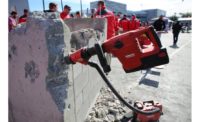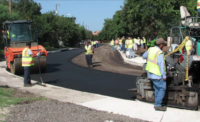
Grant Quasha is the CEO of Eco Material, a leading producer and supplier of cement products using supplementary cementitious materials (SCMs) and other alternative material sources. The company has made significant investments in recent years to expand its supply of SCMs beyond traditional sources of waste materials produced by coal-fired power plants. Quasha spoke with ENR about the current and future prospects for alternative materials in the cement supply chain. This interview has been edited and condensed for clarity.
ENR: Eco Material is a company that covers a lot of businesses across the cement sector, and people may not realize how deeply established you are in the market for alternative cementitious materials.
Quasha: The Eco Material name is only a few years old, but we’re composed of probably a dozen businesses that have been operating since the 1970s in cementitious material replacement. Two and a half years ago, we merged Boral Resources with Green Cement—the biggest ash and SCM supplier in the country, now with the largest provider of near-zero carbon cement.
In the past few years we’ve expanded our business, not away from but in combination with our business of bringing produced fly ash into the ready-mix market. But because supply of that material will be less available over time, we’ve invested more and more in novel SCMs: harvested fly ash, bottom ash, beneficiated bottom ash, natural pozzolans and green cement binders. We’re the leaders in cement and concrete decarbonization.
Are you seeing a push for sustainability and green construction driving your business, or is it in shifting regulations?
Our business has been strong for many years, but frankly the number-one selling point for our material was cost and performance characteristics. Why [state departments of transportation] specify ash and other SCMs in projects is due to performance characteristics, such as a reduction in the alkali silica reaction [compared to traditional concrete]. But in the last five years, the last couple of years really, another element increasingly important as a selling point is that green angle. Not only are our products a cost-efficient way to improve performance, but they are a cost-effective way to reduce carbon. So for that ‘green premium,’ customers would rather use our product. And as regulations change, the more forward-looking states and Europe may increasingly mandate its use.
How has your supply chain evolved, given the changing energy mix in the U.S. and the reduction in coal power plants?
So 10 to 15 years ago, there was an oversupply of fly ash in the market, probably 50 million tons of fly ash produced annually. Today that number is less than half that. Additionally, of those tonnages, what was once a majority and now a minority is now off-spec and doesn't meet the ASTM specification. The amount of on-spec material produced from coal-fired plants today is probably less than half of what it was 10 to 15 years ago. Today most everything [in the ash supply that is] on-spec is being used in production of on-spec concrete. And a lot of usage [in construction] was set at that 10- to 15-year-ago range.
So how does Eco Material keep meeting demand despite the declining supply?
Right now our products are generally priced at a zero to 30% discount compared to ordinary portland cement. But ash is produced where power is produced, not where it’s needed for construction. And it’s a low-value material to ship and store. We’ve invested tremendously in storage, and logistics to move it where it is needed.
We’ve seen a real change in the market overall. In many [regional] markets, they don’t have much material left at all. In California, there is no more coal-fired power production in the state—all that comes in needs to be transported from out of state. We ship in thousands of tons per year there.
That’s why we invested so heavily in new materials, and harvesting of landfilled ash we can dig it up, beneficiate it and put to use.
In our business, we sell virtually all of the on-spec fly ash we get. We have to invest to get it out of waste dumps. And when we beneficiate the bottom ash [another coal-fired generation byproduct], it historically has a lower value. We have pioneered that. So not only have we taken all the available traditional supply, we have to pull from various other sources, and that all requires technical expertise. We’re pretty uniquely well positioned.
Let’s talk about the logistical puzzle of getting materials where it needs to be. How is that changing?
We sell a low value product, it's [priced on average] at $80 a ton. There’s a power plant in Southern Illinois—before we worked with them they’d landfill 3 million tons a year of coal ash, gypsum, etc. We now use [almost all] of that, and a substantial portion goes on trains to California. It’s a lot of logistics to fully utilize this material.
We have to be a customer-focused business. We have our own ready-mix concrete providers—we don’t pour but we [sell concrete to those who do]—and over 50 utility partners. We’re about half the market in the country. Some of our competitors say we supply everyone but are not giving them a deal, but that’s not accurate. You've got to make the pie big enough that everyone can profit. The best way to do that, in our business with so much scale, is to increase scale.
We make investments not just in our own physical logistics, but in our software and analytics. We have significant investments in our optimization and logistics modeling, thousands of supply routes from one place to another, finding the optimal solution to avoid disposal for utility partners and move the most [material] to customers.
Over time as we invest more in harvesting and manufacturing operations [the shifting supply and demand is] less of an issue. But the tail doesn’t wag the dog—plants don’t run to produce ash, they run to produce power, so there can be issues.
So how do you structure those relationships with utilities to meet demand?
Our contracts with utilities fall into two buckets. One is that as they produce ash on a plant-by-plant basis, a plant will contract with us for five years and we sell [it to the construction market], then after our costs we pay a royalty to the utility. That’s the traditional model.
But more and more now we’re looking at non-traditional supplies, and that requires investment. You can’t just point at an ash pile and dig in when it has sat there for decades. You need a purpose-built facility to dig it out, dry it, screen it, see if it’s within spec. Often that requires additional technology and work. Usually we co-invest with utility on the capital needed for that. Once we’re up and running, it looks more traditional, it runs when we think it should run, purpose-built to produce ash on demand.
Right now we sell about 6 to 7 million tons a year of as-produced ash from utilities. We have nine projects in development that will provide an incremental 4 million tons a year of non-traditional ash or SCMs. Ten years ago that was 0% of the market, 5 years ago it was 2% of the market, so it will increase dramatically.
Are you seeing any big shift from states or federal entities requiring greater use of SCMs in their projects?
Frankly we haven’t seen any big uptick from state or federal requirements. California did it first years ago, set a timetable for 2030 for significant reduction of portland cement and clinker. New York state and [the U.S. General Services Administration] have longer timetables.
But it does give us a road map to where we go tomorrow. We’re not just going to tread water with today's supply of SCMs—we can increase it dramatically. We are in an industry where traditional demand remains strong, but because of government action demand should double again in the next 5 to 10 years.
With the traditional supply [of ash and other SCMs] decreasing, we have a tremendous opportunity to meet that challenge. And we’re thinking longer term as well—we make a good profit, and in the last few years we’ve invested all that and then some in future of the business.
What about updating specifications for these new materials? ASTM has said they are considering a performance-based standard for SCMs.
With ASTM, it's happening slowly, because standards move slowly, as they should. We [as an industry] are building critical infrastructure here, and need to make sure it performs as expected. But I do think there is a broad shift that is staring to occur, and needs to occur from [prescriptive] specifications to performance-based specifications. Certainly there are DOTs that are more progressive on that. I see that occurring, but it could occur a little bit more quickly.
We’ve seen lots of success in new products we brought online. In Texas, the largest concrete market [in the U.S.], we’re working with the state DOT to get approval for non-traditional materials, and it could work out great with that market. Should we do more? I think so. We have folks in some of our trade groups on various committees who seem to be interested.
Speaking of those kind of successes, are there any recent business expansions or newer products you’d like to note?
A real highlight for us is Texas, and in the central region, we’ve been bringing on lot of new material—beneficiated fly ash, bottom ash products, synthetic pozzolans—all blessed by TxDOT and going very well. Additionally in Texas, we've expanded our operations in Jewett, Texas. We’ve almost doubled production capacity from 100,000 to 200,000 tons a year [at the Texas plant] on PozzoSlag, a pozzolanic material that exceeds Grade 120 Slag in some characteristics. We’ve invested heavily in that, and have had that up and running with the new expansion now for a few months.





